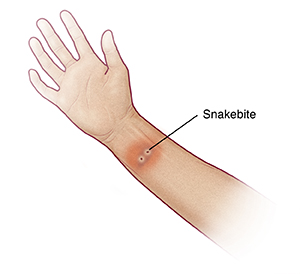You have been treated for snake venom poisoning. This may have affected the skin, fatty tissue, muscles, nerves, joints, and blood vessels in the area of the bite. Depending on how severe your condition is, it may take a few weeks to a few months to heal. Most people with snakebites who are treated early with a medicine called antivenom (antivenin) will recover fully. In rare cases, you may have some lifelong (permanent) injury to the nerves or muscle. This may be numbness or loss of joint function.
In some cases, you may have a delayed allergic reaction to the antivenom that you were given. This is not common. But if this happens, symptoms often start 7 to 14 days after treatment. Symptoms may include rash, itching, hives, joint or muscle aching, and fever. These are often mild. They can be treated with antihistamines and other medicines.
Snake venom can affect how your blood clots. This can lead to abnormal bleeding. Treatment with antivenom fixes this problem. But sometimes the clotting problem happens again up to 2 weeks after treatment. So, it's important to keep your appointments for follow-up testing.
Home care
-
For an arm or hand bite, keep the arm raised (elevated) as much as you can until the swelling goes down. For a leg or foot bite, raise the leg as much as you can. If it hurts to put weight on the leg, use crutches until you can walk without pain. Once the swelling has gone down, an elastic stocking (support hose) or an elastic wrap will help prevent the leg from swelling again when standing or walking.
-
You may have started physical therapy in the hospital. This is something you can keep doing at home. If directed by your healthcare team, soak the arm or leg in warm water. This can be in a spa tub, a bathtub, or a shower. After a few minutes, begin range-of-motion exercises at each joint affected. This will reduce stiffness, improve the range of joint motion, and help local circulation. This should be done every day until you feel the function is back to normal. If swelling gets worse after a heat treatment, use ice packs to reduce swelling. Make your own ice pack by putting ice cubes in a plastic bag that seals at the top. Wrap the bag in a clean, thin towel. Never put ice or an ice pack directly on the skin. Lower the water temperature next time.
-
If you have a blackened area of skin at the bite site, this must be cleaned at least once a day. Follow all wound care directions from your healthcare team. After removing the dressing, wash the area with soap and water. Keep the wound covered with a sterile dressing.
Follow-up care
Follow up with your healthcare provider, or as advised.
Call 911
Call
-
Shortness of breath, dizziness, or fainting
When to get medical advice
Call your healthcare provider right away if any of the following occur:
-
Redness around the wound
-
Swelling or pain around the wound, or the bitten arm or leg gets worse
-
Drainage from the wound
-
Fever of 100.4°F (38°C) or higher, or as directed by your healthcare provider
-
New areas of bruising, or abnormal bleeding
-
Itching, rash, or hives
-
Joint aching
-
Change in the color or amount of urine


